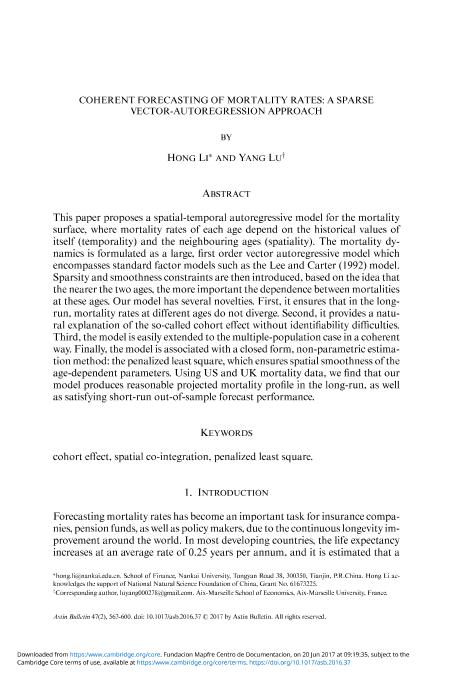Coherent forecasting of mortality rates : a sparse vector-autoregression approach

Contenido multimedia no disponible por derechos de autor o por acceso restringido. Contacte con la institución para más información.
| Tag | 1 | 2 | Value |
|---|---|---|---|
| LDR | 00000cab a2200000 4500 | ||
| 001 | MAP20170019848 | ||
| 003 | MAP | ||
| 005 | 20170621141554.0 | ||
| 008 | 170614e20170501esp|||p |0|||b|spa d | ||
| 040 | $aMAP$bspa$dMAP | ||
| 084 | $a6 | ||
| 100 | $0MAPA20170005766$aLi, Hong | ||
| 245 | 1 | 0 | $aCoherent forecasting of mortality rates$b: a sparse vector-autoregression approach$cHong Li, Yang Lu |
| 520 | $aThis paper proposes a spatial-temporal autoregressive model for the mortality surface, where mortality rates of each age depend on the historical values of itself (temporality) and the neighbouring ages (spatiality). The mortality dynamics is formulated as a large, first order vector autoregressive model which encompasses standard factor models such as the Lee and Carter (1992) model. Sparsity and smoothness constraints are then introduced, based on the idea that the nearer the two ages, the more important the dependence between mortalities at these ages. Our model has several novelties. First, it ensures that in the longrun, mortality rates at different ages do not diverge. Second, it provides a natural explanation of the so-called cohort effect without identifiability difficulties. Third, themodel is easily extended to themultiple-population case in a coherent way. Finally, themodel is associated with a closed form, non-parametric estimationmethod: the penalized least square, which ensures spatial smoothness of the age-dependent parameters. Using US and UK mortality data, we find that our model produces reasonable projected mortality profile in the long-run, as well as satisfying short-run out-of-sample forecast performance. | ||
| 650 | 4 | $0MAPA20080555306$aMortalidad | |
| 650 | 4 | $0MAPA20080579258$aCálculo actuarial | |
| 650 | 4 | $0MAPA20080602437$aMatemática del seguro | |
| 700 | 1 | $0MAPA20170007913$aLu, Yang | |
| 773 | 0 | $wMAP20077000420$tAstin bulletin$dBelgium : ASTIN and AFIR Sections of the International Actuarial Association$x0515-0361$g01/05/2017 Volumen 47 Número 2 - mayo 2017 , p. 563-600 |

